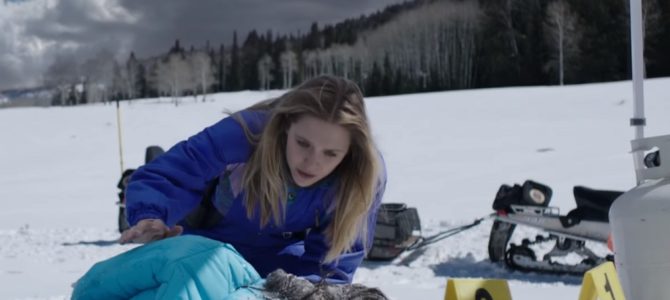
“Wind River” is easily the best movie to have premiered at the 2017 Sundance Film festival, and is now available on Netflix. It’s a nuanced, well-told story of life in Wyoming on and off the Wind River Reservation.
The film does justice to a state many people only know from visits to Yellowstone, or a ski trip to Jackson Hole, or perhaps a summer trip to the rodeo in Cheyenne. The setting is an integral part of this story.
Wyoming is the ninth largest state by land area, but it has the smallest population in the nation by far, even including Puerto Rico and Washington DC, with only 585,501 people in the whole state. Many U.S. cities have populations in excess of our state’s whole population. This fosters an isolation that can be hard for people in the rest of the nation to grasp. This isolation sets the stage for the crimes at the center of the film and the hardships for the law enforcement investigating wrongdoing in it.
The Setting Helps Drive the Plot
Elizabeth Olsen plays Jane Banner, a rookie FBI agent from Tallahassee, Florida. She is sent to help tribal police with a murder and a rape because she’s the nearest officer, and her discomfort at the whole situation is one of the best written parts of this film. When Banner initially meets the tribal police chief and other star of the movie, Jeremy Renner playing Cory Lambert, the U.S. Fish and Wildlife service agent who found the murdered woman, she points out that there are only six officers trying to patrol and police an area the size of Rhode Island and Delaware, together.
It’s impossible and improbable for six people to do this job well, not because they don’t care or want crimes to go unsolved but because the resources are inadequate. A rape kit needs to be sent some 360 miles away for processing in Loveland, Colorado, because that’s the nearest place with capacity. Lambert’s assistance with the case uncovers his connections with the reservation, his painful past, and deep connection to the crime, and why he’s so personally invested in helping the FBI agent solve it. “Wind River” isn’t just a typical crime drama, it’s also the story of how isolation changes people, both for the better and the worse.
It’s in this setting that the character- and crime-driven “Wind River” grips you. I don’t watch a lot of crime movies, but I watched this one on the recommendation of a local friend. She described it as intense and warned me I would cry, and she was right.
I’m a Wyoming transplant, here for some seven years, but I’ve been to the places in this film. The scenery and resiliency of the people is so familiar. For example, Lambert pushes aside Banner’s ideas about luck, because surviving in Wyoming’s winters takes more than that. People die in the snow, like in the movie, even in the capital.
A Fake Crime that Emulates True Crime
One of the most sobering parts of the movie comes after it ends. The closing title cards note that while missing person statistics are tracked for all U.S. demographics, they’re not kept for Native American women. No one knows how many are missing. There are some 14,000 residents on Wind River, and life expectancy on is short, at only 49 years.
Between the high suicide rate, an unemployment rate over 80 percent, and a drug problem that has gotten worse despite help from federal agencies, Wind River struggles with the kinds of problems many people tend to associate with developing nations. The New York Times compared the reservation’s joblessness to that of Zimbabwe, and noted the people there can expect to live 20 years fewer than an Iraqi. Wind River is one of the country’s most dangerous reservations.
Many of the jobs in the region are either very low-paying and service-based, in gas stations or tiny convenience stores, or they require a clean drug screen that people in the grips of addiction can’t pass, like the oilfield jobs. The oilfields in the movie present another real-life problem that might be surreal for people outside Wyoming and other areas with reservations.
Law enforcement’s complicated and conflicting jurisdictions due to antiquated precedent that allows Indian tribes to run as mini-nations despite Native Americans’ U.S. citizenship is another important plot focus in the film, organically woven in multiple scenes. FBI agents can only investigate certain crimes, including homicide, but not assault or rape. An oilfield leased on federal land, however, is a touchy no-man’s-land where the county and tribal police have no authority and require an FBI agent to interact with workers.
This Confusion Stymies Justice for Victims
“Wind River” invites viewers to investigate how these things are happening so quietly in our country. The Department of Justice keeps some pertinent statistics: 84.3 percent of Native American and Alaskan Native women have experienced violence in their lifetimes; 56 percent have experienced sexual violence. Of Native American and Alaskan men, 81.6 percent have experienced violence in their lifetimes; 27.5 percent have experienced sexual violence. These are striking numbers, and the individual stories of heartache and loss that make up each of these numbers inspired the film’s storyline.
Some affected families have told their stories, including how difficult or impossible it is to really get answers for violent deaths on the reservation. CNN has a lengthy story about the families of three girls who died in 2008 under circumstances that have never been cleared up. The girls were 13, 14, and 15 years old, and died from methadone overdoses in what were ruled homicides.
The men responsible were reportedly only sentenced to two years in Wyoming prisons, and the victims’ families were never able to find out what happened or why on the night their daughters died. The details of their sentencing and pleas are also sealed, keeping these families from closure in their grief.
“Wind River” also ends with no solutions, and no tightly wrapped ends. This is not a movie to watch for a happily ever after, where the good guys sweep in and fix all the problems, because that would do a disservice to all of the people living and dying in Wind River. Instead, it presents an uncomfortable mash-up of gorgeous scenery depicting mountains covered in snow against deteriorating homes, wrecked families, and the tragic loss of young lives.









